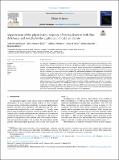Por favor, use este identificador para citar o enlazar a este item:
http://hdl.handle.net/10261/280014COMPARTIR / EXPORTAR:
 SHARE SHARE
 CORE
BASE CORE
BASE
|
|
| Visualizar otros formatos: MARC | Dublin Core | RDF | ORE | MODS | METS | DIDL | DATACITE | |

| Título: | Improvement of the physiological response of barley plants to both Zinc deficiency and toxicity by the application of calcium silicate |
Autor: | Paradisone, Valeria; Navarro-León, Eloy; Albacete, Alfonso CSIC ORCID; Ruiz, Juan Manuel; Esposito, Sergio; Blasco, Begoña | Palabras clave: | Barley Organic acids Oxidative stress Phytohormones Silicon Zinc |
Fecha de publicación: | 17-mar-2022 | Editor: | Elsevier | Citación: | Plant Science 319:111259 (2022) | Resumen: | An adequate availability of Zinc (Zn) is crucial for plant growth and development given the essentiality of this element. Thus, both Zn deficiency and Zn toxicity can limit crop yields. In plants, the responses to Zn imbalances involve important physiological aspects such as reactive oxygen species (ROS) accumulation, phytohormone balance, tricarboxylic acid cycle (TCA) metabolism, and organic acids (OAs) accumulation. However, a way to improve tolerance to stresses such as those produced by nutritional imbalances is the application of beneficial elements such as silicon (Si). In this study, we grew barley plants in hydroponics under Zn deficiency and toxicity conditions, applying Si in the form of CaSiO in order to assess its effectiveness against Zn imbalances. Parameters related to plant growth, oxidative stress, TCA enzyme activities, phytohormones and OAs accumulation were analyzed. Both Zn deficiency and toxicity reduced leaf biomass, increased ROS accumulation, and affected phytohormone and OAs concentrations and TCA enzyme activities. CaSiO treatment was effective in counteracting these effects enhancing Zn accumulation under Zn deficient conditions and limiting its accumulation under toxic conditions. In addition, this treatment decreased ROS levels, and improved ascorbate/glutathione and phytohormonal responses, citrate synthase activity, and malate/oxalate ratio. Therefore, this study enhanced the notion of the efficacy of CaSiO in improving tolerance to Zn imbalances. | Versión del editor: | http://dx.doi.org/10.1016/j.plantsci.2022.111259 | URI: | http://hdl.handle.net/10261/280014 | DOI: | 10.1016/j.plantsci.2022.111259 | Identificadores: | doi: 10.1016/j.plantsci.2022.111259 issn: 1873-2259 |
| Aparece en las colecciones: | (CEBAS) Artículos |
Ficheros en este ítem:
| Fichero | Descripción | Tamaño | Formato | |
|---|---|---|---|---|
| Paradisone2022PlantSci.pdf | 1,59 MB | Adobe PDF |  Visualizar/Abrir | |
| Paradisone2022PlantSciSup.docx | 14,91 kB | Microsoft Word XML | Visualizar/Abrir |
CORE Recommender
SCOPUSTM
Citations
6
checked on 12-may-2024
WEB OF SCIENCETM
Citations
4
checked on 29-feb-2024
Page view(s)
29
checked on 15-may-2024
Download(s)
49
checked on 15-may-2024
Google ScholarTM
Check
Altmetric
Altmetric
Este item está licenciado bajo una Licencia Creative Commons

